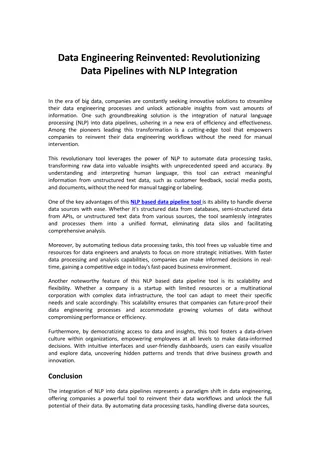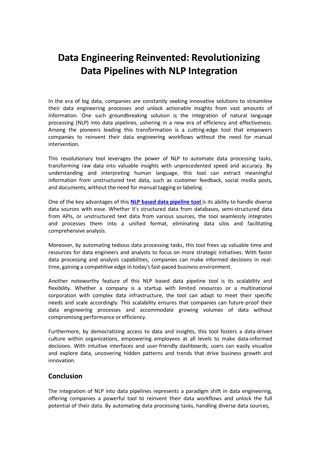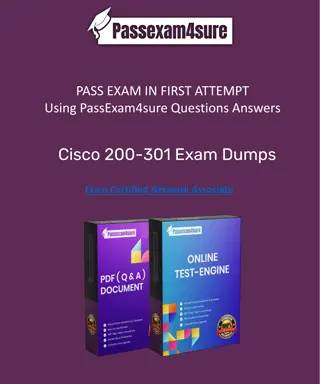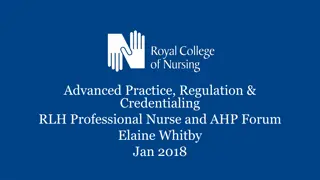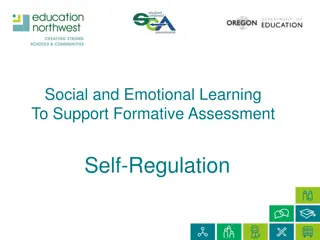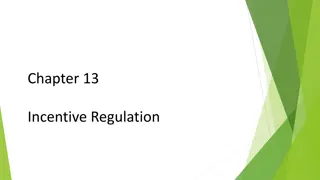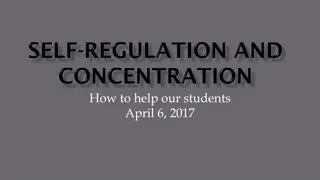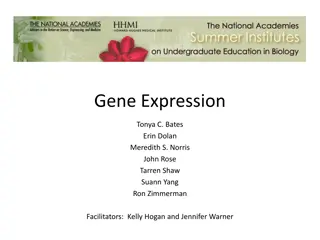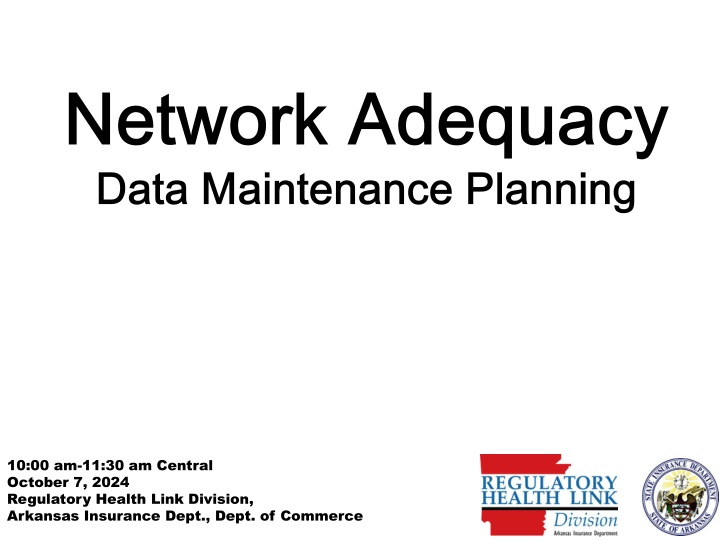
Regulatory Health Link Division Meeting Highlights & Timeline
"Explore key points discussed at the Regulatory Health Link Division meeting regarding PTNP data maintenance and timeline for certification reviews. Learn about the challenges and decisions impacting Arkansas Insurance Department regulations."
Download Presentation

Please find below an Image/Link to download the presentation.
The content on the website is provided AS IS for your information and personal use only. It may not be sold, licensed, or shared on other websites without obtaining consent from the author. If you encounter any issues during the download, it is possible that the publisher has removed the file from their server.
You are allowed to download the files provided on this website for personal or commercial use, subject to the condition that they are used lawfully. All files are the property of their respective owners.
The content on the website is provided AS IS for your information and personal use only. It may not be sold, licensed, or shared on other websites without obtaining consent from the author.
E N D
Presentation Transcript
10:00 am-11:30 am Central October 7, 2024 Regulatory Health Link Division, Arkansas Insurance Dept., Dept. of Commerce 1
Agenda 1)Introductions & housekeeping. 2)Recap. 3)Change Summary. 4)Caution over APCD originated purges. 2
PTNP Data Maintenance Why? Industry agreement on the classification of individual providers and facilities, who treat Arkansans, into Provider Types defined by Arkansas. This agreement is key to AID s evidence-based Network Adequacy regulation. 3
PTNP Data Maintenance Why? Industry agreement on the classification of individual providers and facilities, who treat Arkansans, into Provider Types defined by Arkansas. required under CMS-CCIIO Time and Distance standards. This agreement is key to AID s evidence-based Network Adequacy regulation. 4
Agenda 1)Introductions & housekeeping. 2)Recap. 3)What will be published? 4)Federal Provider types. 5)Details on the initial seed template. 6)Timeline. 7)The challenge of the first review. 8)Questions. 5
Recap. CMS-CCIIO NA Time and Distance standards applicable PY2026 AID decided to have one NA standard in the state thereby CMS-CCIIO NA Time and distance standards becomes applicable starting PY2026. Rule 106 will be amended as the Department works the kinks in the implementation With no Federal guidance on data governance for common understanding of provider classifications, the Department decided to keep it s industry-collaborative data governance process running, but with entirely new data. Change from the existing Arkansas provider types to CMS-CCIIO provider-types with different definitions has created challenges and demands on the regulator-industry collaborative for common understanding of provider classifications. AID intended to participate in the Provider-Type-NPI-Pool (PTNP) process for the first time using the APCD and other analysis, just like any other issuer and expects to be subject to the voting process. 6
Timeline PTNP rounds & certification review Last round before we go live with CCIIO T&D stds We are engaged in this round Certification Review for PY2026 PTNP Round 2 of 2024 PTNP Round 1 of 2025 mid-Aug, 2024 mid-March, 2025 mid-May, 2025 mid-Dec, 2024 Jan 1, 2026
PTNP Round 2 of 2024 (First cut of Federal Requirements) Issuers & AID meet Issuers & AID meet Stage 1 (Issuers suggesting changes) 13 days Stage 2 (Issuers voting) 28 days 40 days 42 days 11/18/2024 Votes from Issuers 10/7/2024 Consolidated suggestions by AID 12/16/2024 Finalized PTNP by AID 9/24/2024 Add/Delete Suggestions from Issuer 8/15/2024 -Initial template published 8
PTNP Round 1 of 2025 (First cut of Federal Requirements) Stage 1 (Issuers suggesting changes) 16 days Stage 2 (Issuers voting) 14 days 30 days 28 days 2/28/2025 Votes from Issuers 1/31/2025 Consolidated suggestions by AID 3/14/2025 Finalized PTNP by AID 1/15/2025 Add/Delete Suggestions from Issuer 12/16/2024- Initial template published 9
Urging caution over APCD based corrections AID is urging caution against its own suggestion based on NPIs disappearing from the APCD in recent years. Motivation behind Department s effort to use the APCD was to make it easier on the issuers by shrinking the size of the PTNP list starting at 41K rows. Disappearing NPIs from APCD claims seemed reasonable to purge as outdated data. The Department does not want to make things worse in its effort to help in the collaborative data maintenance program by suggesting this APCD based purge. APCD based cleanup amounts to using billing systems to clean the Network systems. The Department urges issuers to consult with experts who have understanding of both, the billing and network systems if the APCD based cleanup is a good idea in the first place, and accordingly vote. Lastly, with our limited APCD experience, data teased out from the APCD should NOT be accepted without some vetting. 13
Discussions & Questions Discussions & Questions Email RHLD.DataOversight@arkansas.gov 14
Additional Reference slides APPENDIX APPENDIX 15
Errors to avoid during Stage 1: Suggestions for change (1 of 3) Please understand that PTNP data maintenance is NOT just about your network(s) alone. DO not attempt to remove a provider who is not in your network anymore but may work for others. Please understand that our PTNP data maintenance attempts to focus on actual provider practice rather than academic qualifications. For example, a provider who is qualified in Internal Medicine but is known to work only in the ER of a hospital, should not be classified as a Primary Care Provider. Please remember we are communicating about correcting classifications of NPIs (i.e. Providers). Not whether a NPI (i.e. Provider) exists. Each line communicates either addition of an NPI to a C- bucket OR- removal of an NPI from a C-bucket . A misclassified NPI *may* require two or more suggestions. One would be a removal from the incorrect C-bucket and if not already assigned to the applicable C-bucket(s) , addition(s) to the correct C-bucket(s) . Sometimes a misclassification may require only one suggestion- a removal from a C-bucket with no concomitant addition suggestions, since an appropriate C-bucket does not exist for the NPI. Try not to approach the PTNP data maintenance with an inclination towards one type of action (say an inclination towards either addition or deletion). AID tends to compare competitor networks before issuing an objection. Just focusing on say additions and not on removal of inaccurate NPI classifications may not help you in AID s comparative analysis. Please approach the PTNP data maintenance as an effort towards accurate classification. While adding bordering state providers, please remember that AID does not have any contiguous county requirement. But bear in mind though that adding providers very far from the borders may not help with your average distance calculations. Add providers in bordering states that Arkansans do avail because your consumers are probably the best judge. 16
Errors to avoid during Stage 1: Suggestions for change (2 of 3) While removing a misclassification for a provider be careful not to remove other classification for the same NPI that may be correct. For instance while cleaning up misclassified Endocrinologist NPIs, AID observed issuers removing correct association of those NPIs with Oncology. While adding a NPI to a C-bucket , please pay heed to the taxonomic definition of the C-bucket . Same consideration applies when looking for removals. For instance the current definition of C250 (Access to Dental General) does not include Pediatric Dentists, so do not add them to Dental General . Conversely if you know an NPI listed in Dental General is an Pediatric Dentist by practice, ask for its removal. Doprovide your most compelling reason for an addition or deletion. Each issuer s reasons behind an addition or removal is shown to all issuers during the voting round and may influence their feedback. During vote processing AID may overrule the direction of a vote based on the strength of an issuer s reason. An example of a compelling reason for removal of a PCP can be a brief Works only in emergency medicine in our 2016 claims data . Download and use the correct template to suggest changes. Please do not fashion your own spreadsheet. AID had observed significant feedback in the voting stage (that comes later) saying that a particular NPI should belong to some other bucket. Please understand that the Suggestions for change stage is the stage to add or remove from an classification. The voting stage that comes later, is not the place to make addition or removal suggestions. 17
Errors to avoid during Stage 1: Suggestions for change (3 of 3) When a facility changes ownership, it gets a new NPI. When adding this NPI remember to delete the NPI associated with the previous owner. Before adding an NPI to a provider bucket, ensure that the NPI does not already exist in that bucket. Remember we are doing this data maintenance because the NPI Registry does not have the adequate data quality for provider classifications. Therefore, do not be quick to re-classify a provider existing in the PTNP final list solely based on the taxonomy in the NPI Registry 18
Errors to avoid during Stage 2: Voting stage (1 of 1) Most network data considerations during the add-remove stage also apply to the Voting stage; Taxonomic definitions, Out-of-state provider distance considerations, etc. should be considered. For example, before objecting to some other issuer s removal of an apparently valid NPI- C bucket combination, consider if the provider is out of state, and if all practicing locations are far from the border. Please use the recommended template. Please remember that this stage is only to communicate your agreement or rejection of a suggested change of provider classification. It is not about communicating whether a NPI (i.e. Provider) exists or that the provider is miss-classified and should belong to a different bucket. While rejecting an addition suggestion, if you realize that the NPI belongs to a different C-bucket, your opportunity for suggesting the addition to the appropriate C-bucket(s) will be in future PTNP data maintenance rounds. Suggestion to add to a different C-bucket cannot be handled at this stage. Do provide your most compelling reason behind rejecting an addition or deletion. AID may use the strength of your reason to settle a tie, or even reverse the direction of a vote. An example of a compelling reason for rejecting addition of a NPI as a PCP can be a terse Works only in emergency rooms per claims data . 19


